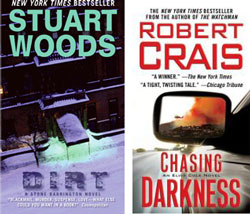
Books: Stuart Woods and Robert Crais
Books: MacDonald’s “Galton Case” and “Black Money”
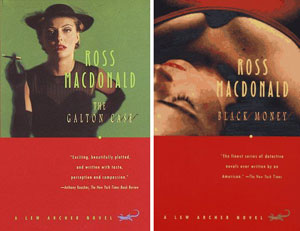
MacDonald wrote 18 Archer books 1949-1976 (he died in 1983).
I’d read five MacDonald books, but still had two on my shelf (all rescued from used bookstores). Henning Mankell’s “The Pyramid” was the 100th book I’d read from the Black Lizard imprint. I decided to start the next 100 with those two Lew Archer books. I read them both during a three-day period while recovering from surgery.
“The Galton Case” is by far the best Lew Archer book I’ve read. An aging wealthy woman hires Archer to find her son, who disappeared 20 years before along with his streetwise bride. That part is solved in fairly short order. But by then the book has become a murder mystery, Nevada gangsters have shown themselves, an old murder surfaces, an apparent grandson appears, and…well, it just keeps getting more and more interesting. The plot takes Archer to Ontario a couple times. This was a highly satisfying book. It totally surprised me, and that’s not easy to do.
I then moved on to “Black Money.” A rich young fellow hires Archer to learn the identity of a suave guy known simply as “the Frenchman,” who has wooed away his girlfriend. Much of the book involves untangling the Frenchman’s identity. But mixed in is a seven-year-old suicide, gambling debts, money laundering, and a bunch of rich people.
MacDonald’s books are rollercoasters. There is no down time, no time for reflection, no private interlude with a girlfriend, no nice meal. It’s all plot. When Archer needs to get from San Francisco to Ontario, it takes a paragraph. You don’t read anything about the journey. He’s just gets on a plane, and a couple sentences later he’s knocking on a door. You really need to concentrate, because there is no chance to catch your breath. MacDonald is well worth the ride.
Book: The Girl Who Played with Fire
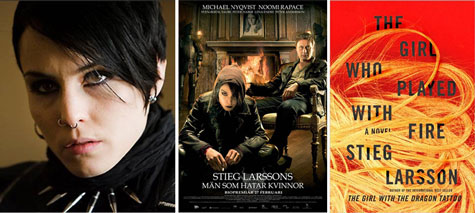
L-r: Lisbeth Salander, as played by Swedish actress Noomi Papace in the movies; a movie poster (picturing Salander and Mikael Blomkvist); the American publication.
I just finished the Black Lizard publication of “The Girl Who Played with Fire,” an amazing book. It’s the sequel to Stieg Larsson’s “The Girl with the Dragon Tattoo,” which stormed the US (and Europe before that) in 2009 (which I reviewed in December 2009). They are the two best mysteries/thrillers I’ve read in a long while.
A third book in the series, “The Girl Who Kicked the Hornet’s Nest,” was published in hardback in the US in May 2010. The three books are known as the Millennium Trilogy.
 Stieg Larsson (right), a Swede, turned in all three books to a publisher in 2004, and the first book (called “Men Who Hate Women” in Sweden) had just been published…and then he died of a massive heart attack. He was 50. Since he and his companion of 32 years, Eva, never married, the entire estate went to Larsson’s father and brother; she got nothing. This is a big scandal in Sweden, though their laws are pretty clear. A case of bad planning.
Stieg Larsson (right), a Swede, turned in all three books to a publisher in 2004, and the first book (called “Men Who Hate Women” in Sweden) had just been published…and then he died of a massive heart attack. He was 50. Since he and his companion of 32 years, Eva, never married, the entire estate went to Larsson’s father and brother; she got nothing. This is a big scandal in Sweden, though their laws are pretty clear. A case of bad planning.
They had no idea these books would become a worldwide sensation. The three books became the number 1, 2, and 3 bestsellers in Sweden, and the same pattern repeated in other countries. In 2008, Larsson was the second-highest-selling author in the world. In 2009, all three books were released as movies in Sweden. To date, 27 million copies have been sold in 40 countries.
The title character, Lisbeth Salander, may be the most interesting heroine you’ll ever read about.
To envision Lisbeth Salander, start with the goth stereotype–black clothes, piercings, tattoos, anti-social, introverted. She’s 4-foot-9 inches tall and weighs 90 pounds. Add a severely dysfunctional childhood and a total distrust of “the system,” which has let her down repeatedly. Then add genius qualities–an expert computer hacker, photographic memory, amazing resourcefulness. And a willingness to resort to violence when threatened.
She is joined by Mikael Blomkvist, a middle-aged investigative journalist with the magazine “Millennium,” thus the title of the series. Blomkvist is well-known in Sweden for his exposes. He and Salander have a strange relationship, mainly because she distrusts everyone and is emotionally bankrupt. They are not a “couple,” but end up working together.
 “The Girl Who Played with Fire” starts pretty much where “The Girl with the Dragon Tattoo” left off, though it mostly occurs two years later. It starts with an upcoming, blockbuster Millennium expose of sex trafficking, but turns into a murder mystery, and then gets taken over by plotlines from “Dragon Tattoo.” Halfway through the book, Salander disappears entirely for a long period as a full-fledged police investigation begins, and Larsson acquaints us with the persons on the police team.
“The Girl Who Played with Fire” starts pretty much where “The Girl with the Dragon Tattoo” left off, though it mostly occurs two years later. It starts with an upcoming, blockbuster Millennium expose of sex trafficking, but turns into a murder mystery, and then gets taken over by plotlines from “Dragon Tattoo.” Halfway through the book, Salander disappears entirely for a long period as a full-fledged police investigation begins, and Larsson acquaints us with the persons on the police team.
It’s difficult to figure out where the book is going, but you can’t pull yourself away. I was sucked in, and just had to keep reading, utterly hooked. Larsson jumps from one character to the next, a few paragraphs or a few pages with each, juggling a host of different perspectives, motives, and agendas. But everything comes together in the end. The plot is very complicated, yet easy to follow. A lot happens in those 630 pages.
Larsson wrote the books in his spare time. His main preoccupation was running an organization that documented and exposed right-wing extremism and racial and religious intolerance. He and Eva lived their last 15 years under death threats from extremist groups, and the threats were real. One reason they never married is that Swedish law requires that married couples make public an address; for security reasons, Stiegg and Eva kept their lives out of the public view.
The third book, “The Girl Who Kicked the Hornet’s Nest,” start immediately where “The Girl Who Played with Fire” ends. I’m anxious to see where the story goes, and may not have the patience to wait for the Black Lizard paperback version in 2011.
Larsson envisioned a ten-book series. Eva still has possession of an unfinished manuscript for the fourth book, and I read that he left a synopsis for books 5 and 6. But his books are so unique, I can’t imagine turning them over to some other writer. Larsson is gone, and I greatly doubt he can be replaced.
Book: “Eight Lives Down”
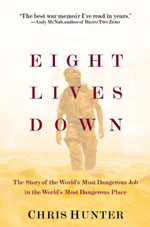 “Eight Lives Down,” by Chris Hunter, is the reality version of “The Hurt Locker,” the 2009 Oscar winning film. The subtitle says, “The Story of the World’s Most Dangerous Job in the World’s Most Dangerous Place.”
“Eight Lives Down,” by Chris Hunter, is the reality version of “The Hurt Locker,” the 2009 Oscar winning film. The subtitle says, “The Story of the World’s Most Dangerous Job in the World’s Most Dangerous Place.”
The author, a British major, spent four months in Iraq in 2004 as a bomb tech–or, more correctly, an ATO: Ammunition Technical Officer. He was already an expert in this field, having served previously in the Balkans, Northern Ireland, Columbia, and elsewhere. When there was an IED or a car bomb, he was called out to diffuse it. The title alludes to the 9 lives of a cat. Considering his ultra-dangerous work, Hunter figures he had one life left.
In two months’ time, Hunter responded to 45 bomb incidents. He was so good at his job that the insurgents put a price on his head, and began designing bombs with the sole purpose of killing him when he responded. For that reason, his superiors pulled him from field duty and gave him a job looking for the bomb makers, using forensic and other evidence. Before he left Iraq, the two main bomb-making groups in Basra had been eliminated.
Hunter tells a number of stories of diffusing bombs. The bombs keep growing in sophistication, thanks to the Iranians. Early on, he and his squad of seven other men were caught in a terrible ambush and fought their way out of it. Hunter is good at making you feel like you’re there.
 I’ve read several books about our current two wars, but this is the first one from a non-American perspective. It was interesting seeing how British troops behave and interact with each other–not much different from American troops, except perhaps a bit more straight-laced. They are certainly highly trained warriors.
I’ve read several books about our current two wars, but this is the first one from a non-American perspective. It was interesting seeing how British troops behave and interact with each other–not much different from American troops, except perhaps a bit more straight-laced. They are certainly highly trained warriors.
And what a sense of humor! Here are some quotes from the book:
- “When you make something idiot proof, someone just makes a better idiot.”
- From helicopter gunship operators: “You can run, but you’ll just die tired.”
- “Those who live by the sword get shot by guns.”
It was also fun wading through all the British jargon: beezer, bollocks, judder, bumf, gobsmacked, biff, blokes, recce. Notice how many of them start with the letter “b.” Either the British like “b” words, or we Americans just don’t like incorporating “b” words from other languages.
Here’s a story. Hunter and three Americans are watching a live feed from an unmanned drone. About five persons are preparing what looks to be a car bomb. Suddenly there’s a flash, and when the picture returns, there’s only a black cloud where the car once stood. “They got love from above,” said one American.
While in Baghdad, heading to the airport, Hunter watches a car pull out of traffic, barrel through street-side shops and pedestrians, and then blow up–a horrific car bomb. The dead and maimed are everywhere. Hunter watches a young woman retrieve her father’s severed hand from atop a vehicle.
They learn that the Iraqi police had captured two bomb-makers. Hunter and Lisa, a British captain, march into the Basra police headquarters, where prisoners are being openly tortured. They barge into a room where the two bombers are being tortured and demand custody of them. The police chief objects, but the woman puts the guy in his place. In that society, the police chief probable had to go kill some prisoners to restore his honor. They walk out of the headquarters with their two prisoners, who then divulge everything they know.
A number of superb books are being written about the Iraq and Afghanistan wars. “Eight Lives Down” is among them, a most fascinating book. It’s not in the league of “Joker One” or “The Forever War” or “Moment of Truth in Iraq,” but it does give two unique perspectives–the British, and the harrowing role of bomb techs.
Books: Mongolia, France, and the Florida Keys
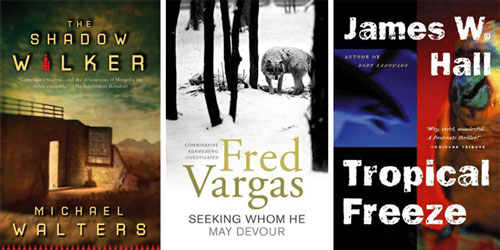
One advantage of being laid-up is that I’ve been able to do lots of reading. Here are three books I read over a period of four days, the week after my April 16 surgery.
I enjoy mysteries set in other countries, and with detectives from those countries (rather than some American on a foreign jaunt). I’ve read mysteries set in Sweden, Iceland, Nazi Germany, Italy, China, Japan, Bosnia, and elsewhere. Now I’ve added a far more exotic country: Mongolia.
“The Shadow Walker,” a 2008 book by first-time novelist Michael Walters, involves a series of grisly murders which, as the plot develops, seem to involve the gold-mining industry and foreign businesses. The Mongolia we see is trying to struggle out of Third World status and away from its recent Soviet/communist past.
Frankly, the book somewhat disappointed me. There was plenty of local color, but the plot fell flat for me. It moved slowly, with little happening. Too much unnecessary dialogue. A lot of the procedural stuff could have been summed up, rather than forcing us to read mundane details. It came to a conclusion, but not a satisfying one. My thought was, “I read 350 pages for this?”
“Seeking Whom He May Devour,” (2006), by Frenchwoman Fred Vargas, is set in the mountains of southern France. This is a “Chief Inspector Adamsberg” mystery. Lots of sheep, and the occasional human, are being killed by what seems to be a very big wolf and its owner.
It’s sort of a road trip book, as three somewhat quirky characters–a woman and two men–head off to follow the killer’s route and hopefully catch him. Inspector Jean-Baptiste Adamsberg eventually joins them. It was an enjoyable plot, and you learn a lot about wolves and the French police system. I liked Adamsberg.
“Tropical Freeze,” a 1989 book from James W. Hall, is an oddball piece set in the Florida Keys. It’s like a Carl Hiaasen or Elmore Leonard book–quirky characters, and a plot that wanders to and fro and ultimately decides to end.
We’ve got our protagonist named Thorn, an FBI friend working for the local bad guy, a beautiful weathergirl, an inept criminal named Ozzie, a spinster librarian/computer hacker, and other assorted folks. They usually do the unexpected, and anything they plan out is inevitably thwarted through stupidity or happenstance. So if the reader thinks he knows what’s going to happen next, he’s wrong.
Hall is a very good writer, and the book teems with texture and a sense of place. You feel like you’re in Florida. But I’m not really a fan of this kind of meandering plot. I prefer a straightforward, “Here’s the mystery. Now let’s solve it.”
Jesse Stone Books and Movies

When I had my operation on April 16, I was reading Robert Parker’s “Stranger in Paradise,” the latest in his Jesse Stone series. I finished it the next morning. These books, written in third person (unlike his Spenser and Sunny Randall books), center on the sheriff of smalltown Paradise, on the Massachusetts coast. Stone is a former LA cop who views Paradise as his last stop before retirement. (The Spenser characters have a way of showing up in the other two series; Jesse Stone makes an appearance in a couple Spenser books.)
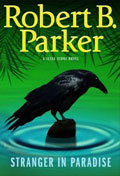 “Stranger in Paradise” involves mobsters and gangs, and an old heist. The most interesting character in this book is Crow, yet another of Parker’s good-hearted stone-cold killers. Jesse Stone is intent on putting Crow away, and yet they strike up an amiable relationship, totally understanding each other.
“Stranger in Paradise” involves mobsters and gangs, and an old heist. The most interesting character in this book is Crow, yet another of Parker’s good-hearted stone-cold killers. Jesse Stone is intent on putting Crow away, and yet they strike up an amiable relationship, totally understanding each other.
I got the impression that Crow would be the first in a rogue’s gallery of criminals whom Stone could call on when needed. The Spenser books have Hawk, Vinnie Morris, Chollo, Tedy Sapp, Ty-Bop, and Junior–all tough guys and killers who are ever-ready to help Spenser when needed. If he thinks Susan is in danger, or someone else, he’ll summon one of these guys for bodyguard duty.
Crow would fit right in with them. But with the death of Robert Parker, I don’t imagine Crow will be joined by anyone else.
During the past month of so, we watched the five Jesse Stone TV movies, starring Tom Selleck in the title role. These are very good movies. They have a definite tone, a smalltown feel (a bit like the Twilight movies, without the bloodsucking), with the same tranquil music which slows everything down.
Selleck is perfectly cast. As I read “Stranger in Paradise,” I could picture Selleck in every scene, and could hear him say every line of dialogue. He plays Stone as a low-geared fellow, very understated, never excited. Just plods along, solving the crime. I loved, absolutely loved, those movies.
Books: Two by Joe Lansdale
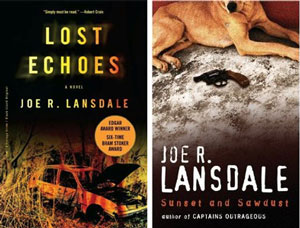 Joe Lansdale is quickly becoming one of my favorite authors. He excels at developing memorable characters, and his plots are unusual.
Joe Lansdale is quickly becoming one of my favorite authors. He excels at developing memorable characters, and his plots are unusual.
Both of these books are set in East Texas–“Sunset and Sawdust” in the 1930s Depression, “Lost Echoes” in the present.
“Lost Echoes” is a 2007 book in the Vintage Crime / Black Lizard imprint–the 99th Black Lizard book I’ve read. The protagonist, Harry Wilkes, has the ability to “see” terrible events which occurred in whatever place he’s in–murders, rapes, car accidents, domestic violence. A vision takes over, and it’s like he’s there watching it happen.
This takes over his life. He keeps a notebook detailing places to avoid, lest he get entrapped in another vision. Alcohol is one way to keep the visions at bay.
Harry meets up with another alcoholic, a very interesting guy named Tad who’s also a martial artist, and they both climb on the wagon together.
Harry’s childhood crush, Kayla, enters the picture, and they set about trying to solve the murder of her father many years before. Other people come and go, and you’re not sure what role they play in the story, but there’s a role of some kind.
It’s a good story. The ending gets a bit crazy, but I say that in a good way.
“Sunset and Sawdust,” written in 2004, begins with a woman–named Sunset, because of her red hair–shooting her husband in the head while he’s beating and raping her (and while a tornado is taking their house apart). He’s the police constable, and when they need a new one, she ends up getting the job. Not without opposition.
This book is a companion of sorts to “The Bottoms,” an astoundingly good book set in East Texas during the Depression. Both show the extreme racism of that time and place, with blacks cowering in subservience, always knowing they can get lynched for practically anything. His black characters are compelling.
Lansdale develops at an unhurried pace, introducing new characters only after you’ve had time to get acquainted with the previous ones. Two bodies are found, and Sunset and her makeshift police force try to unravel what happened. It gets complicated. Some people die, some live. The story resolved to my complete satisfaction.
“Sunset and Sawdust” is a better book than “Lost Echoes,” but “The Bottoms” is the best of the three.
Book: “The Pyramid,” by Henning Mankell
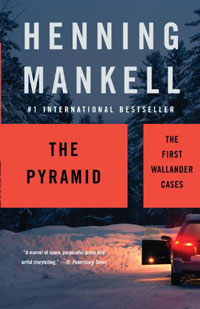 Henning Mankell’s nine-book series about Chief Inspector Kurt Wallander begins in January 1990. Wallander is 42, divorced, a father, and has risen through the police ranks. He started out in Malmo, then transferred to the smaller city of Ystad, where all of the Wallander books occur. So there’s a lot we don’t know about Wallander.
Henning Mankell’s nine-book series about Chief Inspector Kurt Wallander begins in January 1990. Wallander is 42, divorced, a father, and has risen through the police ranks. He started out in Malmo, then transferred to the smaller city of Ystad, where all of the Wallander books occur. So there’s a lot we don’t know about Wallander.
“The Pyramid: The First Wallander Cases” fills in the blanks with five stories which span the year from 1969, when Wallander is a 21-year-old patrolman, to the first Wallander book, “The Faceless Killers.” I expected a somewhat disjointed book. And yet, the five stories hold together real well as a whole.
“Wallander’s First Case” (100 pages) occurs in 1969 when our protagonist is patrolman in Malmo, preparing to transfer to the detective division. He looks into an apparent suicide in his apartment building, and it turns into a murder mystery. We also meet his fiance, Mona, and we can tell this marriage won’t work out.
“The Man with the Mask” occurs on Christmas Eve in 1975. Wallander is married to Mona, has a daughter (Linda), and will soon begin a new job in Ystad. This 30-page story finds him confronting a robber/killer at a gas station. It’s a fascinating piece.
“The Man on the Beach” occurs in Ystad in 1985. It’s a simple, interesting little murder mystery. Wallander’s marriage is on the rocks.
“The Death of the Photographer” (60 pages) occurs in 1987. Wallander is now divorced.
The final story, “The Pyramid,” occurs in 1989. It’s a large plot involving international drug-running, and has the feel of a full-blown Wallander book condensed into 160 pages. The book ends with Wallander receiving an early morning call about a new murder, which is the beginning of “The Faceless Killers.”
The five stories tell a lot about Wallander, and are interesting stories in themselves. I particularly liked the two 30-page stories. I wasn’t expecting a lot from this book, and was pleasantly surprised.
Book: “Joker One” (a Superb Iraq War Story)
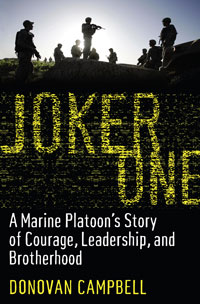 “Joker One: A Marine Platoon’s Story of Courage, Leadership, and Brotherhood,” left me in tears. It really did.
“Joker One: A Marine Platoon’s Story of Courage, Leadership, and Brotherhood,” left me in tears. It really did.
Donovan Campbell led the platoon called Joker One during five months in 2004 in Ramadi, a major city in Iraq’s Anbar Province. When they arrived in March 2004, a year after the invasion, things were dangerous, yet fairly calm. But the insurgency exploded in April and continued until Joker One left in September…and it then continued for a couple more years. Their battalion took more casualties than any battalion–Marine or Army–since Vietnam.
The book’s subtitle says it well: a story of courage, leadership, and brotherhood.
I was initially conscious of the leadership part–Campbell’s leadership, starting in the States with pre-deployment training. He led by example, with strength, and with sensitivity. I realized that he would make a good pastor; in many ways, he was a shepherd for his men. And it was servant leadership. He was there to serve and protect his men. That theme prevailed throughout the book.
The first 150 pages take place in the States and in the early days of their time in Ramadi. Then, with the section titled “Fierce,” come 150 pages of regular combat. You see the grind of daily fighting take its toll on the men, and on Campbell. You also see the professionalism, strength, competence, morality, and awesome firepower of the American soldier.
There is nothing flashy about Campbell’s writing. But he communicates with authenticity. He clearly acknowledges his own failings, and doesn’t dwell on the things he does well. He earned a Bronze Star with Valor, but he never mentions it in the book.
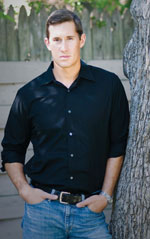 Campbell (left) throws some deserved barbs at Paul Bremer, the civilian leader whose decisions caused so much havoc in Iraq. During the summer of battle, with friends dying around him, he muses about people in the States obliviously heading out on their vacations. In August, “America focused on something totally incomprehensible to us–the 2004 Summer Olympics.” It shows how much the war had been removed from our minds.
Campbell (left) throws some deserved barbs at Paul Bremer, the civilian leader whose decisions caused so much havoc in Iraq. During the summer of battle, with friends dying around him, he muses about people in the States obliviously heading out on their vacations. In August, “America focused on something totally incomprehensible to us–the 2004 Summer Olympics.” It shows how much the war had been removed from our minds.
Campbell muses occasionally on spiritual subjects, and in evangelical terminology, though he never explicitly identifies himself as a Christian or even as a man of faith. I found that most interesting.
Near the end, in chapter 37, he talks in biblical language about love and sacrifice. It’s an amazing chapter–my favorite, the one that choked me up–as he reflects on Joker One.
“For me, then, loving Joke One–something I so desperately hoped that I did–meant much more than simply feeling that I cared. It meant patience when explaining something for the fifth time to a 19-year-old who just didn’t get it. It meant kindness when dealing with a Marine who had made an honest mistake while trying his hardest; mercy when deciding the appropriate punishment. It meant dispensing justice and then forgetting that it had been dispensed, punishing wrong and then wiping the slate clean.
“Love was joy at the growth of my men, even when it diminished my own authority. It was giving the credit for our successes to the team while assuming all the responsibility for our failures on myself. It was constantly teaching my men, sharing everything with them until I had nothing left to give, with the expectation and the hope that they would become greater then me. It was making myself less so that they might become more. Love accepted the Marines for exactly who they were and never believed that it was all they would be….
“So that was how we loved those who hated us; blessed those who persecuted us; daily laid down our lives for our neighbors….Now I understand more about what it means to truly love, and what it means to love your neighbor–how you can do it even when your neighbor literally tries to kill you.” He mentions Bolding, a Marine killed while trying to protect some Iraqi children. “Bolding had lived out the greater-love principle to its fullest possible extent.”
Campbell writes in the tradition of the soldier-poet, rather than of the foul-mouthed sergeant telling it like it is. He’s authentic and introspective, and I felt I truly learned a lot about the American soldier.
Book: “The Fifth Floor,” by Michael Harvey
“The Fifth Floor,” the second book starring private investigator Michael Kelly by author Michael Harvey, is a winner, just like Harvey’s previous “The Chicago Way.” Both are part of the Black Lizard imprint from Vintage Books.
The title refers to the floor of the Chicago city building which houses the mayor’s office. The plot starts with a spousal abuse case, and morphs into a murder mystery, and then a historical mystery going back to the 1871 Great Chicago Fire. Plenty of city political intrigue.
Plus a Barack Obama kind of character–a young charismatic black named Mitchell Kincaid who comes out of nowhere to run for mayor. But the incumbent mayor would get nasty, in true Chicago fashion, before giving up his job. One character, about Kincaid’s chances, says, “Please. Barak Obama is one thing. He was only running for president. Kincaid wants to be mayor.”
Harvey keeps things moving. There are no wasted, gratuitous scenes. Every scene, and every character, matters to the plot. He keeps several little subplots going, all inter-related, and wraps up every single one of them.
Harvey also plays fair, avoiding the tendency (like Chandler and others) to let the protagonist unravel the mystery in a nice speech at the end, using clues not previously available to the reader. I always hate that; it’s one of my pet peeves. Harvey actually lapsed into that a little bit, during the last 100 pages, but he extracted himself from it and I don’t hold it against him.
“The Fifth Floor” is the 98th book of the Black Lizard imprint that I’ve read. I’ve already decided that Henning Mankell’s “The Pyramid,” just released in the US last fall (it showed up under the Christmas tree–thanks, Pam) will be the 100th. But right now, I need to go pick out Number 99.





